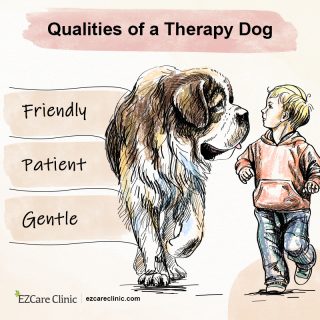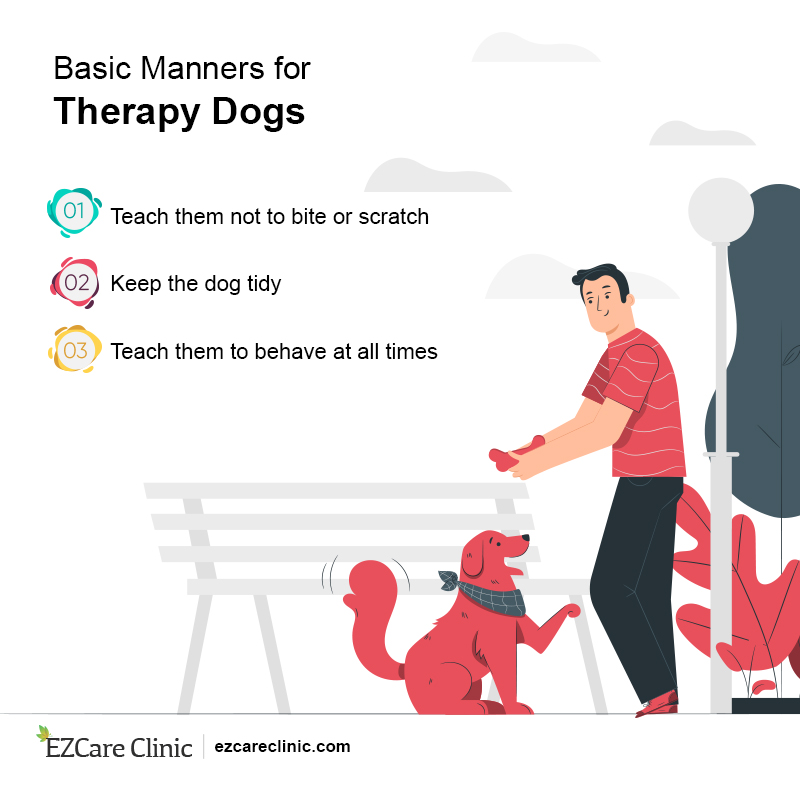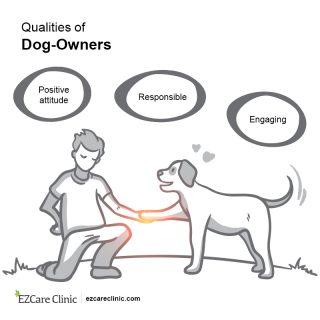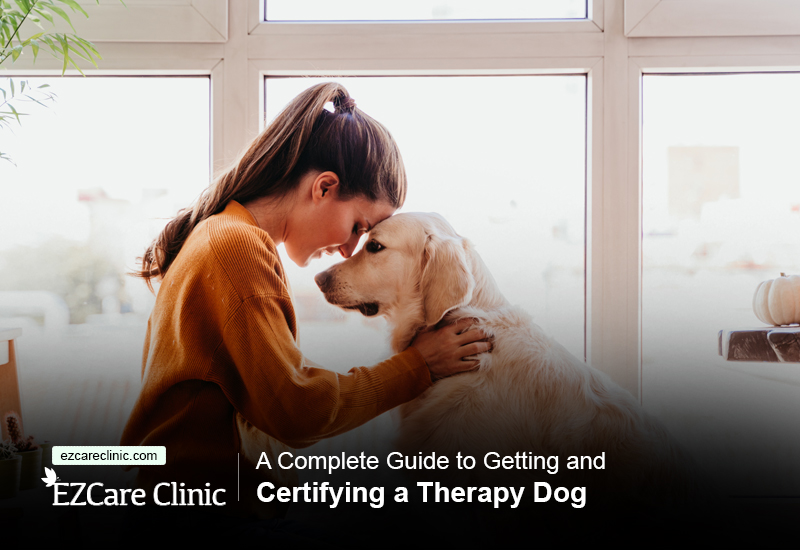According to animal-assisted therapy research findings by the UCLA Health department, therapy animals have proven beneficial to patients with several health conditions. Patients struggling with autism, dementia, and psychological disorders like anxiety have shown tremendous improvement once they develop a connection with their therapy animals.
Get your authentic ESA letter from a licensed physician by clicking the button below!
However, there are no moral laws that protect the owners of these therapy animals. Hence, they end up like regular pets. That could be because the therapy animal only interacts and supports you, compared to a support animal that helps you get by your day-to-day activities.
Therapy dogs are more than average pets. They help you and others near you. So, if you plan on getting a therapy dog, keep reading for a detailed account of the complete processing and documentation of getting one.
By the time you get to the end, you will understand your therapy dog, thus making your journey more comfortable and exciting.
What Is a Therapy Dog?
The American Kennel Club, AKC, defines a therapy dog as a dog specially trained to work with the owner to improve others’ lives. This could range from helping a kid in school to visiting a senior in a home.
However, you must note that a therapy dog is NOT a service dog. And while service dogs are free to fly and book restaurants, therapy dogs do not have the same privileges.
What Is the Difference Between a Pet and a Therapy Dog?
Unlike an ordinary pet, a therapy dog undergoes training to perform a particular duty to comfort the owner. You need to complete some paperwork, evaluation tests, registration, and certification to own a therapy dog.

Difference Between Pets and Therapy Dogs
Therapy dogs provide comfort and live in hospitals, nursing homes, and retirement homes. These dogs help people stay calm and collected and are allowed in institutions like schools and colleges, depending on the recipient’s needs.
The Difference Between Therapy Dogs and ESAs
Emotional support animals come as a prescription to complement treatment plans for people with psychological and physical conditions. For this reason, they are covered under the Federal Housing Act, as well as the Americans with Disabilities Act. On the other hand, therapy dogs get no superior protection.
Process of Certifying Your Dog as a Therapy Dog
Getting your dog certified as a therapy dog is easy and straightforward. If you are interested in a stress-free process of certifying your therapy dog, keep reading.
But first, here is an overview of what you can expect from reading this piece:
- Recognizing your need for a therapy dog
- Connecting with a licensed mental health professional
- Demonstrating why you need the therapy dog
- Adopting a furry friend
- Training your dog to be a therapy animal
- Finding an organization for the certification
- Understanding the evaluation criteria of therapy dogs
- Making sure that you are and your partner qualify for the role
- In-person evaluation
- Preparing a budget for your therapy dog
- Understanding the legal status of therapy dogs
Let’s get you started:
1. Recognizing Your Need for a Therapy Dog
As mentioned above, a therapy dog works with you to improve the lives of the people around you. Hence, the first step is to identify anyone who could use your help and that of a therapy dog.
If you assess your environment and notice someone who could benefit from a therapy dog, then go ahead and get one. You can get a therapy dog for people in hospitals and nursing homes once you are sure that the dog will benefit them.
Now, how do you know if the therapy dog can make a difference in people’s lives around you? Ask yourself:
- Are the people around you tired all the time?
- Did terrible past life experiences change them?
- How well do they manage their mental and physical tasks?
- Do they follow through with their tasks to completion?
- What do they say about forgetting horrible experiences in their lives?
- Are they always on edge and have difficulty focusing?
If you evaluate the situation and notice affirmative answers to most questions listed above, get a therapy dog.
Get in touch with us and book an appointment for more information.
How Do Therapy Dogs Help?
For mental health:
- Increases mental stimulation, which assists in the recall of memories
- Acts as a catalyst to a relatively slow healing therapy session
- Petting the therapy dog helps the patients relax
- Providing comfort and lowering loneliness
- Therapy dogs help people relax and reduce anxiety
- These animals are also a happy distraction
For physical health:
- Children with autism show better social interactions during therapy sessions when they have a therapy dog
- Participating in exercises with a therapy dog increases relaxation
- Reduced blood pressure and better cardiovascular health, hence less medication
- Diminished physical pain
- Prompt the production of ‘happy hormones’ like Phenylethylamine; has the same effects as chocolate

Qualities of a Therapy Dog
Therapy dogs can help patients with body conditions such as:
- Age-related cognitive decline
- Anxiety disorder
- OCD
- ADHD
PTSD - Bipolar Disorder
2. Connecting with A Licensed Health Professional
The recent hype about therapy dogs has resulted in many people offering untruthful services. People out there are pretending to offer ESA/therapy/service animal letters. You could end up falling into a trap.
Get ahead of the situation by knowing which health professionals to consult.
How Do You Verify the Legitimacy of Your Therapist?
Before paying a therapist who recommends a therapy dog, you need to be sure that their services are legit. To confirm this, you can:
- Ask for their license details
- Check the license board that registered the therapist
- Counter-check the license of your therapist online
- Contact the licensing board if you need help verifying the license.
Get your authentic ESA letter from a licensed physician by clicking the button below!
Getting in touch with a reliable therapist is not as easy as ordering pizza. You cannot rely on the yellow pages to find a good therapist. The list below contains essential steps to take when seeking a recommendation for a therapy dog:
- Get recommendations from trusted professionals
- Ask your family and friends for a recommendation
- If you can visit a renowned therapist, then do so
- An insurance company could also offer recommendations
- Use the power of the internet to find a good therapist
Talking to a professional therapist puts your needs into perspective. Now, you understand if you really need the therapy dog or not. If your doctor finds it okay to get a therapy dog, you can get one.
Remember: If you come across anyone claiming to register your therapy dog, they are not truthful.
If you qualify for an Emotional Support Animal, get your ESA letter today!
3. Demonstrating Why You Need the Therapy Dog
Once you have identified a licensed therapist, you can then talk to them about your desire to get a therapy dog. Explain why you think you should get a therapy dog and the people you intend to help. Explain why you think the dog will be an excellent addition to the care given to the people around you, and wait for the results.
If the therapist thinks that you owning a dog will make a difference in people’s lives around you, you can go ahead and get one.
Besides, you can get other types of therapy pets like horses and fish. But above all, make sure that the therapists approve of your intentions to get a therapy dog.
4. Adopting a Furry Friend
Now that you have a recommendation from a licensed therapist, you get to the most crucial part of this whole process: Adopting a dog.
Research before settling on a dog to take home. Some dog breeds perform better as therapy dogs compared to others. However, this should not be your only concern, as the breed is not the only factor to consider.
Ask yourself:
- Which dog can be considered to be the best therapy dog?
- Physical characteristics you prefer in your dog
When you get the answers, you will have chosen a dog with your preferred personality, temperament, and behavior.
Some of the best therapy dog breeds include:
- Pug
- Dachshund
- Greyhound
- Golden Retriever
- Labrador Retriever
- Poodle
- Pomeranian
- French Bulldog

How do Therapy Dogs Help?
Look for a dog with desirable properties. These include:
- Friendly
- Patient
- Confident
- Gentle
- Content with petting
- Being calm in all situations
Note: Get your preferred dog breed from shelters rather than breeders.
Why Should You Find Your Dog From a Shelter and Not the Breeders?
Shelters are known to produce dogs that are friendly, calm, loving, and caring. Also, providing a home for them is fulfilling and bound to improve your life quality. Now, you got the dog from the shelter, but you have no idea how it behaves, what it enjoys doing, or its response to stressful conditions. So, before you begin training, here is what you must do first:
- Play with the dog
- Show your dog love and care
- Observe its behavior and temperament
- Spend enough time with the dog
- Relax with the dog
Once you have a clear idea of what the dog does and responds, you can move on to training.
Click below to get an ESA Letter today!
5. Training Your Dog to Be a Therapy Animal
You can never adopt a dog with the training of a therapy animal. But before you visit anyone in the hospital, you need certification and registration for the therapy animal. You only get the certificate once your dog passes the AKC’s Canine Good Citizen (CGC) test.
The only way your dog can pass the test is through training and learning to be obedient and calm. Spending time with your dog helps you understand it better. Therefore, you can note improvements throughout the training process.
There are various training methods you can employ when training your dog to help others. But you can only get the full scope of the training when you talk to a professional dog trainer.
A trainer makes your work easier and stress-free. Some of the training methods employed include:
- Clicker/ Reward-based treatment
- Leash training
- Socializing
- Basic command training
- Proofing behaviors
How Do You Train a Therapy Dog?
Training a therapy dog is no walk in the park. By the end of the training, the dog should be calm, content with being petted, and super-friendly. Remember, you intend to make the people around you feel loved and comfortable with the dog. Therefore, you need to put in efforts to complement the work of the handler.
Therapy dogs receive training as per the personal requirements of the person it intends to help. This process is more complicated than general training. And despite the starting point, proper training could result in a well-suited therapy dog.
The following tips will help you in training your therapy dog:
1. Adopt a Younger Pup
While therapy dogs should be older when helping others, adopting a younger dog makes training simpler. You can’t teach an old dog new tricks, right? A younger dog learns faster compared to an old dog.
Get in touch with us and book an appointment for more information.
2. Socialize your Dog
Socializing your dog helps it adapt to different conditions and environments. So, when it is time to meet new people, it remains calm and collected.
3. Obtain the American Kennel Club’s Canine Good Citizen Title
The Canine Good Citizen is a behavioral evaluation that your dog must pass for approval as a therapy dog. Go through the test to see whether or not your dog falls under the obedient group. If your little puppy passes the test, there are high chances that it will soon be a therapy dog.
4. Enroll in Therapy Classes
A therapy dog has little use if you have no idea the kind of help to offer the people around you. And if the dog is training to help others, you can always take the training to a personal level by enrolling your dog in therapy classes.
In these classes, the dog learns to provide pure and unconditional love and affection to the people you intend to help. Also, conducting regular assessments enables you to keep track of the dog’s training. From the data, you can then conclude whether your pet qualifies to be a therapy dog.
By the end of the training process, your dog:
- Should be friendly
- Should be loving
- Must be obedient
- Must have a quiet nature
- Must be well socialized
- Must retain their calm
- Must be gentle and relaxed
- Should not be aggressive or get irritated easily
NB: A dog that jumps too often, barks all the time, and never settles down is not fit for use as a therapy dog. This is because they are more likely to induce stress rather than provide a calm environment.

Tips to Train a Therapy Dog
How Long Does It Take to Train a Therapy Dog?
Training a therapy dog is a two-way process. Both the dog and the handler have to put in a lot of effort. However, you would need about a year to fully train a dog to be a therapy animal.
Should you choose to get your dog from the breeders, you can buy an already trained dog, which is very expensive.
6. Finding an Organization for The Certification
Since the introduction of animal-assisted therapy, there have been improvements in the market. More organizations are gaining acknowledgment for their AKC-approved certification process.
These organizations provide the needed certification for your dog to help in therapy and a liability insurance cover during the volunteering sessions.
Today, you can acknowledge your dog’s work and efforts by getting a certificate from an AKC-approved therapy dog organization.
You can choose from the following:
- Bright and Beautiful Therapy Dogs
- Loves on a Leash
- Pet Partners /Delta Society
- Alliance of Therapy Dogs /Therapy Dogs Incorporated
- Therapy Dogs International
Find the complete list of therapy dog registration and certification groups at the American Kennel Club’s website.
Want an ESA? Click on the button below.
7. Understanding the Evaluation Criteria of Therapy Dogs
Before registering your dog as a therapy animal, ensure you meet the following conditions:
- The dog must be up-to-date on vaccines and shots
- It should be at least one-year-old
- Carry the negative fecal exams, negative heartworm test, among others
- Get a medical history from the vet
After completing its training, you can then register your pet as a therapy dog on one of the AKC-approved organizations. Your dog then undergoes an evaluation before being issued with a certificate.
Evaluation of Therapy Dogs
The test checks whether your dog:
- Has the right qualities to be a therapy dog
- Is well-behaved or not
- Is of appropriate age or not
Note: You only receive the certificate when the organization finds your furry partner is fit to be a therapy dog.
The above-mentioned Canine Good Citizen (CGC) test focuses on whether or not the dog will:
- Accept any friendly strangers to come and talk to their owners
- Allow the stranger to pet them
- Allow someone to check its ears as the vet does
- Walk on a loose lead of the owner
- Act on commands of the owner
- Walk through a small crowd
- Respond to a call by the owner
- Behave appropriately in the presence of other dogs
- React to distractions properly
- Can be left with a trusted person
Once the dog passes the CGC test, then you get a therapy dog certification.
Click on the banner and learn all about getting your dog certified as a therapy dog and get therapy dogs certification online.
8. Making Sure That You and Your Furry Partner Qualify for the Role
Before offering therapy assistance to people around you, a therapy dog needs to complete a comprehensive screening. Here, you and your dog do a series of tests to prove that you are fit for each other.
Your Examination
- Whether or not the dog obeys your commands
- Whether or not you can manage your dog in a therapeutic environment
The Dog’s Examination
Temperament
Patients receiving therapy treatment are susceptible to panic attacks. Therefore, they can create a stressful environment for the dog. In such situations, your dog should:
- Not get angry or aggressive
- Not be stressed out easily
- Comfort the patients by caressing and touching them
A dog that is not fond of touching could be aggressive when the owner experiences a panic attack. But, if your dog shows all the above traits and you still want it to be a therapy dog, you can enroll it for some training.
If you are looking for a dog with a good temperament, choose from:
- Golden Retrievers
- Collie
- Saint Bernard
- Great Dane
- Pugs
- Boxers
- Bulldogs
- Staffordshire Bull Terriers
Socially Accepted
A therapy dog should be well-behaved and friendly. However, do not mistake energy for friendliness. Too much energy from your pet could create an uncomfortable environment for the owner.
Some of the friendliest dogs include:
- Goldador
- Labrador Retriever
- Papillon
- Bichon Frise
- Bulldog
- Cavalier King Charles Spaniel
- Coton de Tulear
- English Setter

Basic Manners for Therapy Dogs
Shedding hair
Suppose your therapy dog is for a hospital setting; choosing one that does not shed hair is prudent. Therefore, even patients with allergies can handle the therapy dog. A dog shedding hair also means more work for your staff, which could be a significant problem. Besides, a therapy dog should bring more comfort and relief rather than stress and chaos.
However, if you have a therapy dog that sheds a lot, you could use a few tips to deal with the situation.
How Can I Keep the Dog’s Coat Hair Under Control?
1. Choose a Brush That Suits the Dog’s Coat
Depending on your dog’s coat, whether smooth, curly, rough, has mats, or you have to detangle it, a bristle brush, slicker brush, or wire-pin brush will get the job done appropriately.
2. Feed Your Dog With Healthy Meals
Sometimes your dog will not shed due to natural causes. At times, it is a sign that your dog lacks certain nutrients. Feeding your dog with meals rich in omega 3 is a great way to ensure that their follicles grow to be healthy and prevent hair breakage.
3. Ensure Your Dog Is Well Hydrated
If you have been placing a bowl of clean water in the morning and finding it unshaken in the evening for several days, it might explain why you have been cleaning vast amounts of fur in your house. Please keep your dog hydrated, keeping in mind that your dog should take up an ounce of water per pound of its body weight.
For routine care, you can use these tips to control the shedding:
- Brush your dog regularly
- Keep the coat moisturized by applying some oil, preferably coconut oil
- Ensure your pet owns canine clothing
- Regularly vacuum your pet and your house
To not deal with shedding hair at all, avoid adopting dog breeds known to shed a lot. They include:
- Akita
- Beagle
- Chow chow
- Rottweiler
- Alaskan malamute
- Siberian husky
- Labrador retriever
Get your authentic ESA letter from a licensed physician by clicking the button below!
For dog breeds that do not shed much, you can choose one from this list;
- Shih, Tzu
- Tibetan terrier
- Maltese
- Miniature Schnauzer
- Silky Terrier
- Poodle
- Portuguese water dog
- Bichon Frise
Adaptable nature
An ideal therapy dog should be capable of adapting to its new environment and in a short time. Hence, the dog delivers on the need to bring it to your life, giving you company, support, and comfort. They can only provide this if they are comfortable in the environment themselves. As much as they are supposed to adapt quickly, it depends on the grounds you expose them. Showing love and care in the first days in their new home will quicken this phase.
Factors that will make your pet either adapt quickly or slowly to the new environment includes:
- Whether the dog has been a family dog in the past?
- Did the dog live in a pack before?
- The ability to maintain the therapy dog’s routine in its new home
- Adopting a friendly nature towards it
Dog breeds famous for their adaptable nature
- Beagle
- Boxers
- Chihuahua
- Dachshund
- Labrador retriever
- German shepherd
- Australian cattle dog
- Pitbull Terrier
- Border collie
Qualities Every Dog Owner Should Possess
People will often wonder why they have a distant relationship with their pets. Maybe it is the fact that you lack the following attributes;
-
Positive Attitude
Keeping a positive vibe around your dog will make it want to spend more time with you. Therefore, you can win the dog’s loyalty, love, and commitment. Being negative will only drive them away from you.
If you qualify for an Emotional Support Animal, get your ESA letter today!
-
Being Able to Know When Your Therapy Dog Is Okay and When It’s Not
Although you adopt a therapy dog to be of more service to you, it’s your responsibility to know when they are stressed or ill. Owners with a strong connection to their dogs will often know when something is off. You can check its temperament, their level of interaction that day, or appetite. If you recognize an odd behavior, call a specialist to examine him.
-
Avoid Jerking
Raising your voice to your pet due to anger does no good for your relationship. Let it know calmly that it did something wrong. Ensure that your therapy dog always feels loved and not scared, even when correcting them.
-
Being Responsible
Vast knowledge of how to take care of a dog, maintain its health and security shows that you are ready to take care of your dog. Taking care of a dog might seem challenging for new pet owners, but it shouldn’t if you love them. It would help if you treated them like family, ensuring that they are always safe and meeting their needs at all costs.
-
Be Engaging
If you like your own space, then do not adopt a dog. Dogs brought up in dull environments tend to have some destructive behavior to distract themselves. Ensure you keep your dog busy by engaging them in your daily activities, finding time to take them for walks, and playing with them. They love to have a good time.
-
Ensure Their Security
This is quite ironic because we sometimes bring dogs into our lives to keep us safe. However, it is two-way traffic. As a dog owner, you also have a role to play in the dog’s safety. Ensuring a dog’s safety can take many forms. It could be;
1. Not Unleashing Them in Public
Never unleash your dog in public, especially in new environments. Releasing your dog in public areas poses a risk of losing it. Even worse, they might find their way back home but come with physical injuries. Keep them leashed so that you can control their movement.
2. Ensure Your Dog’s Feed Is Healthy
Keeping your dog healthy applies to all dog breeds. Ensuring that your dog feeds on healthy meals is the pet owner’s responsibility. Keeping anything that the dog is allergic to out of their reach is an excellent way to keep illness concerns at bay. Any intake of anything that could lead to poisoning keeps your dog’s life at stake and means that you spend more on vet checks.
Register your cat or dog as ESA now by clicking the button below!
3. Keep Your Therapy Dog’s Toys Clean
If you care about your pet’s health, ensure that you clean and disinfect the toys regularly. Since they will be playing in the external environment around your home, there’s a chance the toys will collect bacteria and other disease-causing organisms. Cleaning them helps to prevent your dog from getting infections. Not only should you clean the toys, but you should also maintain general hygiene for the dog. Keep them clean, and you will be visiting the vet less often.
-
Maintain Your Dog’s Oral Health
The majority of dog owners might know this, but maintaining your dog’s teeth’ excellent condition is vital. Brushing their teeth with a toothbrush and toothpaste specifically meant for dogs is one great way to take care of their teeth. The same way you strive to maintain the health of your teeth each day, so should you care for your dog’s to keep them strong.
-
Maintain Your Therapy Dog’s Mental and Physical Health
Since you expect your therapy dog to offer you comfort whenever you need it, it is only fair you do the same to them when you can. Maintaining good health, both mental and physical, is one way to show you care about your therapy dog as well as making them comfortable. Scheduling regular casual visits to the vet to get them checked when you feel something is odd will help keep health concerns in check.
9. In-person Evaluation
To ensure that your therapy dog is fit for you and to be around other people, visit an evaluator for a quick evaluation. A therapy dog must comply with the requirements put in place for them to be family dogs. Assessment from an expert ensures that you have a healthy and safe dog that will result in a happy life.

Things to Discuss With Your Therapist
Other Requirements to Consider When Adopting a Therapy Dog
Since dog lovers do not share preferences regarding the dogs they want as their pets, you are not restricted to the kind of dog size or breed you want for a therapy dog, well, except the age. A therapy dog has to be at least one year old. Some other essential requirements include the following:
1. Annual Vet Visits
Keeping the health of your therapy dog in check is not an option. Even when not sick, make a point of taking your dog to a specialist for health checkups. The need for vet checks increases with the age of the dog. For older dogs, more regular vet visits are vital in monitoring their health.
During the annual health checkup, the specialist should check the following;
- Change in appetite
- Change in their physical health (rough coat, loss of hair, feeling itchy, redness, skin irritation)
- Excretion
- Temperament
- Metal health examination
- Behavior
- Vaccination
Ensure that the vet administers a rabies vaccine before taking a therapy dog home. Other vital vaccinations your therapy dog needs include
- Hepatitis
- Parvovirus
- Lyme disease
- Distemper
- Adenovirus, among others
2. Stool Test
Another must do before taking a therapy dog home is a stool test. It is easy to undermine the test’s significance, but it can prevent your dog from numerous infections brought by intestinal worms. If the vet verifies that the dog has no intestinal worms, you can take it with you.
3. Heartworm Test
For this, the vet takes a blood sample and conducts tests to reveal any underlying condition and the presence of heartworms. In case of the existence of heartworms, carry with you the appropriate medication.
Click below to meet with an ESA expert today!
10. Preparing A Budget for Your Therapy Dog
Before you dream of having a therapy dog, you must prepare a budget for your furry friend.
Break this cost into:
1. Cost of the Therapy Dog
If you are operating on a tight budget, then you should probably steer clear of breeders. You could part with $7,000-$30,000 for a fully trained therapy dog. And if you do not have enough cash to adopt a dog, you can wait for the free-adoption days at the shelter.
2. Cost of Certifying your Pet
Most organizations charge a $100 fee for certifying a pet as your therapy dog. For any other dog, the prices range from $100-$200. However, these prices vary among doctors.
11. Understanding The Legal Status of Therapy Dogs
Therapy dogs have no superior protection from the Federal Housing Act or the Americans with Disabilities Act. Therefore, they cannot access public places, except the pet-friendly ones, or where they work, such as nursing homes, hospitals, and retirement homes.
Some restaurants and business centers discourage the presence of dogs.
Below are some of the concerns related to therapy dogs and how to tackle them:
-
Sanitation and Hygiene
Dirty dogs could attract many health issues, especially in hospitals and nursing homes. To resolve this problem, make sure that the therapy dog is neat and tidy at all times.
If you qualify for an Emotional Support Animal, get your ESA letter today!
-
Allergies
Some people are very allergic to dogs. Others suffer from skin irritation, chronic sneezes, and breathing problems. Do not take your therapy dog in places where people could be allergic.
Organize a location away from many people for your meetings to avoid triggering allergic reactions.
-
Lack of Training
An untrained therapy dog could disturb the peace of the people you intend to help. Rowdy and disturbing behaviors could also create problems.
The simple solution to this problem is to have the therapy dog undergo a series of liability tests to determine if they are fit for the job.
-
Safety of Recipients
Before you offer your help to patients with a therapy dog, make sure these furry friends are no threat to the recipient’s health. Make sure the dog is free of bacteria that could trigger infections and health conditions. Finally, make sure that your dog does not scratch or bite the recipient.
Clipping the nails of your therapy dog prevents scratching. Also, make sure your dog passes the CGC test before presenting it as a therapy dog.

Quality of Dog Owners
-
Weaker Bonds
Suppose you want to own a therapy dog and fail to make a strong connection. The dog lacks an exact frame of reference, and the curiosity drives it further away from you. What do you do then?
A simple solution to this problem is timing. Make sure you only get a therapy dog when you are ready for it. If you feel, deep down, that owning a dog will improve your life, make it fuller, then, and only then should you get a therapy dog.
What Are the Benefits of a Therapy Dog?
You must have noticed some benefits of owning a therapy dog when reading through this piece. Other benefits include:
- Improvement of motor skills
- A therapy dog improves dependent and independent movements
- Can help you improve on self-esteem
- It can help improve verbal communication
- A therapy dog is sure to make you happy
- It helps you improve relations with peers
- It reduces boredom and motivates you to exercise
- Owning a therapy dog provides psychological, psychical, and cognitive benefits
- Finally, a therapy dog reduces depression and anxiety
Get your authentic ESA letter from a licensed physician by clicking the button below!
The Take-Away
Now that you have learned about the benefits of owning a therapy dog, you can get one for yourself and those around you.
But before you classify it as a therapy dog, enroll it in a training program to prepare it for the future role. Make sure it has passed a rigorous evaluation and certification process to make things easier on your end.
Although the process seems tedious, you are sure to enjoy every step involved. By the end, you will have a friend and companion who showers you with attention and helps you get through hard times.
Get in touch with us and book an appointment for more information.

